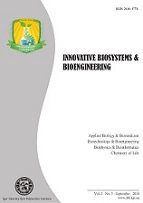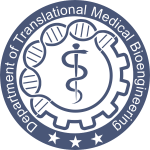The Efficiency of Decellularization of Bovine Pericardium by Different Concentrations of Sodium Dodecyl Sulfate
DOI:
https://doi.org/10.20535/ibb.2020.4.4.214765Keywords:
Pericardium, Decellularization, Sodium dodecyl sulfate, Tissue engineeringAbstract
Background. In modern cardiovasclar surgery, it is a promising method to use xenotissues, which in their properties are close to human tissues, in order to restore the integrity of the heart chambers, its walls or valves. Decellularization of extracellular matrix (EMC) is applied in the process of creation of such bioprotheses. In EMC, the elastin and collagen components are preserved, and antigenic molecules are eliminated resulting in reduction the risk of rejection. The study is devoted to assessment of the histological, molecular-genetic and cytotoxic properties of decellularized bovine pericardium, processed with various concentrations of trypsin enzyme.
Objective. The aim of the work is evaluation of efficiency of bovine pericardial decellularization, based on the use of trypsin enzyme with 1% Sodium Dodecyl Sulfate (SDS) and 0.1% SDS.
Methods. Bovine pericardium was used as a biomaterial for decellularization. Decellularization protocol 1 envisages processing of samples with 0.25% Trypsin solution at 24 °C with constant shaking (200 rpm) along with processing with 1% ionic SDS detergent. The samples, prepared according to protocol 2, were processed with a low concentration of 0.1% SDS. Histological and morphological properties along with detection of nucleic acids concentration in the samples were studied. Matrix samples were cultured in a human fibroblasts cell culture suspension in order to determine cytotoxicity.
Results. Histological examination has not revealed any presence of cells in tissues, decellularized in accordance with both protocols. More than 99% of the nucleic acids was removed from decellularized bovine matrix. During our study, we have not observed cytotoxic effect in vitro for protocol 2 matrix samples, decellularized with only 0.1% SDS. Focal destruction of fibroblasts was observed in conditions of long-term cultivation in protocol 1 samples (Trypsin + 1% SDS). Cells formed abnormal morphological aggregates. Samples of this group have also demonstated sructural changes in collagen and elastin fibers.
Conclusions. Studies have shown that pericardial matrix tissue, decellularized with low-concentration of 0.1% SDS, has the same biological properties as the native pericardium. Decellularization of bovine pericardium, using trypsin enzyme with 1% SDS, has a cytotoxic effect on human cells.References
Mallis P, Michalopoulos E, Dimitriou C, Kostomitsopoulos N, Stavropoulos-Giokas C. Histological and biomechanical characterization of decellularized porcine pericardium as a potential scaffold for tissue engineering applications. Bio-Medical Materials and Engineering. 2017;28(5):477-88. DOI: 10.3233/BME-171689
de Oliveira Lima E, Ferrasi AC, Kaasi A. Decellularization of Human Pericardium with Potential Application in Regenerative Medicine. Arquivos Brasileiros de Cardiologia. 2019;113(1):18-9. DOI: 10.5935/abc.20190130
Gonçalves AC, Griffiths LG, Anthony RV, Orton EC. Decellularization of bovine pericardium for tissue-engineering by targeted removal of xenoantigens. The Journal of Heart Valve Disease. 2005;14(2):212-7.
Naso F, Gandaglia A. Different approaches to heart valve decellularization: A comprehensive overview of the past 30 years. Xenotransplantation. 2018;25(1):e12354. DOI: 10.1111/xen.12354
Pawan KC, Yi H, Ge Z. Cardiac tissue-derived extracellular matrix scaffolds for myocardial repair: advantages and challenges. Regenerative Biomaterials. 2019;6(4):185-99. DOI: 10.1093/rb/rbz017
White LJ, Taylor AJ, Faulk DM, Keane TJ, Saldin LT, Reing JE, et al. The impact of detergents on the tissue decellularization process: A ToF-SIMS study. Acta Biomaterialia. 2017;50:207-19. DOI: 10.1016/j.actbio.2016.12.033
Ramm R, Goecke T, Theodoridis K, Hoeffler K, Sarikouch S, Findeisen K, et al. Decellularization combined with enzymatic removal of N-linked glycans and residual DNA reduces inflammatory response and improves the performance of porcine xenogeneic pulmonary heart valves in an ovine in vivo model. Xenotransplantation. 2020;27(2):e12571. DOI: 10.1111/xen.12571
Helliwell JA, Thomas DS, Papathanasiou V, Homer-Vanniasinkam S, Desai A, Jennings LM, et al. Development and characterisation of a low-concentration sodium dodecyl sulphate decellularised porcine dermis. Journal of Tissue Engineering. 2017;8:1-12. DOI: 10.1177/2041731417724011
Schaner PJ, Martin ND, Tulenko TN, Shapiro IM, Tarola NA, Leichter RF, et al. Decellularized vein as a potential scaffold for vascular tissue engineering. Journal of Vascular Surgery. 2004;40(1):146-53. DOI: 10.1016/j.jvs.2004.03.033
Jelev L, Surchev L. A novel simple technique for en face endothelial observations using water-soluble media - ’thinned-wall’ preparations. Journal of Anatomy. 2008;212(2):192-7. DOI: 10.1111/j.1469-7580.2007.00844.x
Vunjak-Novakovic G, Freshney RI (eds.). Culture of Cells for Tissue Engineering. Hoboken, NJ: Wiley, 2006, 528 p. DOI: 10.1002/0471741817
Blazhevich OV. Cell Cultivation. Minsk: BSU, 2004, 78 p.
Golubev DB, Sominina AA, Medvedeva MN. Guide to the Use of Cell Cultures in Virology. Leningrad: Meditsina, 1976, 224 p.
Roosens A, Somers P, De Somer F, Carriel V, Van Nooten G, Cornelissen R. Impact of Detergent-Based Decellularization Methods on Porcine Tissues for Heart Valve Engineering. Annals of Biomedical Engineering. 2016;44(9):2827-39. DOI: 10.1007/s10439-016-1555-0
Korzhevskiĭ DE. [Application of hematoxylin in histological technique]. Morfologiia. 2007;132(6):77-82.
Alturkistani HA, Tashkandi FM, Mohammedsaleh ZM. Histological Stains: A Literature Review and Case Study. Global Journal of Health Science. 2016;8(3):72-9. DOI: 10.5539/gjhs.v8n3p72
Horobin RW. Biological staining: mechanisms and theory. Biotechnic & Histochemistry. 2002;77(1):3-13. DOI: 10.1080/bih.77.1.3.13
Lilly R. Pathohistological technique and practical histochemistry. Moscow: Mir, 1969, 646 p.
Starodubtsev VB, Karpenko AA, Ignatenko PV, Kim IN, Zoloev DG, Gorbatykh VN. [Short- and long-term results of various methods of reconstruction of carotid artery bifurcation]. Angiologiia i sosudistaia khirurgiia. 2014;20(4):93-9.
Mueller C, Dave H, Prêtre R. Surgical repair of aorto-ventricular tunnel. Multimedia Manual of Cardio-Thoracic Surgery. 2012;2012:mms006. DOI: 10.1093/mmcts/mms006
Chesnov YuM. Biocompatibility of xenopericardium fixed with epoxy compounds in vitro and in vivo experiments. Current Issues in Cardiology. 2002;(2):188-90.
Nonaka M, Iwakura A, Yamanaka K. Technique to treat extensive abscesses in double valve replacement for prosthetic valve endocarditis. The Journal of Heart Valve Disease. 2013;22(4):575-7.
Akhmedov ShD, Afanasyev SA, Dyakova ML, Fatkhutdinov TKh, Kaktursky LV. Using acellular matrix to form new blood vessels and heart using tissue engineering. Genes & Cells. 2009;4(2):32-9. DOI: 10.23868/gc121423
Gilbert TW, Sellaro TL, Badylak SF. Decellularization of tissues and organs. Biomaterials. 2006;27(19):3675-83. DOI: 10.1016/j.biomaterials.2006.02.014
Rieder E, Kasimir M-T, Silberhumer G, Seebacher G, Wolner E, Simon P, Weigel G. Decellularization protocols of porcine heart valves differ importantly in efficiency of cell removal and susceptibility of the matrix to recellularization with human vascular cells. The Journal of Thoracic and Cardiovascular Surgery. 2004;127(2):399-405. DOI: 10.1016/j.jtcvs.2003.06.017
Hudson TW, Zawko S, Deister C, Lundy S, Hu CY, Lee K, Schmidt CE. Optimized Acellular Nerve Graft Is Immunologically Tolerated and Supports Regeneration. Tissue Engineering. 2004;10(11-12):1641-51. DOI: 10.1089/ten.2004.10.1641
Grauss RW, Hazekamp MG, van Vliet S, Gittenberger-de Groot AC, DeRuiter MC. Decellularization of rat aortic valve allografts reduces leaflet destruction and extracellular matrix remodeling. The Journal of Thoracic and Cardiovascular Surgery. 2003;126(6):2003-10. DOI: 10.1016/S0022-5223(03)00956-5
Keane TJ, Swinehart IT, Badylak SF. Methods of tissue decellularization used for preparation of biologic scaffolds and in vivo relevance. Methods. 2015;84:25-34. DOI: 10.1016/j.ymeth.2015.03.005
Tran HLB, Dinh TTH, Nguyen MTN, To QM, Pham ATT. Preparation and characterization of acellular porcine pericardium for cardiovascular surgery. Turkish Journal of Biology. 2016;40(6):1243-50. DOI: 10.3906/biy-1510-44
Oswal D, Korossis S, Mirsadraee S, Wilcox H, Watterson K, Fisher J, Ingham E. Biomechanical characterization of decellularized and cross-liked bovine pericardium. The Journal of Heart Valve Disease. 2007;16(2):165-74.
Andrée B, Bela K, Horvath T, Lux M, Ramm R, Venturini L, et al. Successful re-endothelialization of a perfusable biological vascularized matrix (BioVaM) for the generation of 3D artificial cardiac tissue. Basic Research in Cardiology. 2014;109(6):441. DOI: 10.1007/s00395-014-0441-x
Crapo PM, Gilbert TW, Badylak SF. An overview of tissue and whole organ decellularization processes. Biomaterials. 2011;32(12):3233-43. DOI: 10.1016/j.biomaterials.2011.01.057
Schmitt A, Csiki R, Tron A, Saldamli B, Tübel J, Florian K, et al. Optimized protocol for whole organ decellularization. European Journal of Medical Research. 2017;22:31. DOI: 10.1186/s40001-017-0272-y
Hashemi SS, Jowkar S, Mahmoodi M, Rafati AR, Mehrabani D, Zarei M, Keshavarzi A. Biochemical Methods in Production of Three-Dimensional Scaffolds from Human Skin: A Window in Aesthetic Surgery. World Journal of Plastic Surgery. 2018;7(2):204-11.
Elder BD, Eleswarapu SV, Athanasiou KA. Extraction techniques for the decellularization of tissue engineered articular cartilage constructs. Biomaterials. 2009;30(22):3749-56. DOI: 10.1016/j.biomaterials.2009.03.050
Xing S, Liu C, Xu B, Chen J, Yin D, Zhang C. Effects of various decellularization methods on histological and biomechanical properties of rabbit tendons. Experimental and Therapeutic Medicine. 2014;8(2):628-34. DOI: 10.3892/etm.2014.1742
Caralt M, Uzarski JS, Iacob S, Obergfell KP, Berg N, Bijonowski BM, et al. Optimization and Critical Evaluation of Decellularization Strategies to Develop Renal Extracellular Matrix Scaffolds as Biological Templates for Organ Engineering and Transplantation. American Journal of Transplantation. 2015;15(1):64-75. DOI: 10.1111/ajt.12999
Manalastas TM, Dugos N, Ramos G, Mondragon JM. Effect of Decellularization Parameters on the Efficient Production of Kidney Bioscaffolds. Applied Biochemistry and Biotechnology. 2021;193(5):1239-51. DOI: 10.1007/s12010-020-03338-2
He M, Callanan A., Lagaras K, Steele JAM, Stevens MM. Optimization of SDS exposure on preservation of ECM characteristics in whole organ decellularization of rat kidneys. Journal of Biomedical Materials Research Part B: Applied Biomaterials. 2017;105(6):1352-60. DOI: 10.1002/jbm.b.33668
Downloads
Published
How to Cite
Issue
Section
License
Copyright (c) 2020 The Author(s)

This work is licensed under a Creative Commons Attribution 4.0 International License.
The ownership of copyright remains with the Authors.
Authors may use their own material in other publications provided that the Journal is acknowledged as the original place of publication and National Technical University of Ukraine “Igor Sikorsky Kyiv Polytechnic Institute” as the Publisher.
Authors are reminded that it is their responsibility to comply with copyright laws. It is essential to ensure that no part of the text or illustrations have appeared or are due to appear in other publications, without prior permission from the copyright holder.
IBB articles are published under Creative Commons licence:- Authors retain copyright and grant the journal right of first publication with the work simultaneously licensed under CC BY 4.0 that allows others to share the work with an acknowledgement of the work's authorship and initial publication in this journal.
- Authors are able to enter into separate, additional contractual arrangements for the non-exclusive distribution of the journal's published version of the work (e.g., post it to an institutional repository or publish it in a book), with an acknowledgement of its initial publication in this journal.
- Authors are permitted and encouraged to post their work online (e.g., in institutional repositories or on their website) prior to and during the submission process, as it can lead to productive exchanges, as well as earlier and greater citation of published work.









